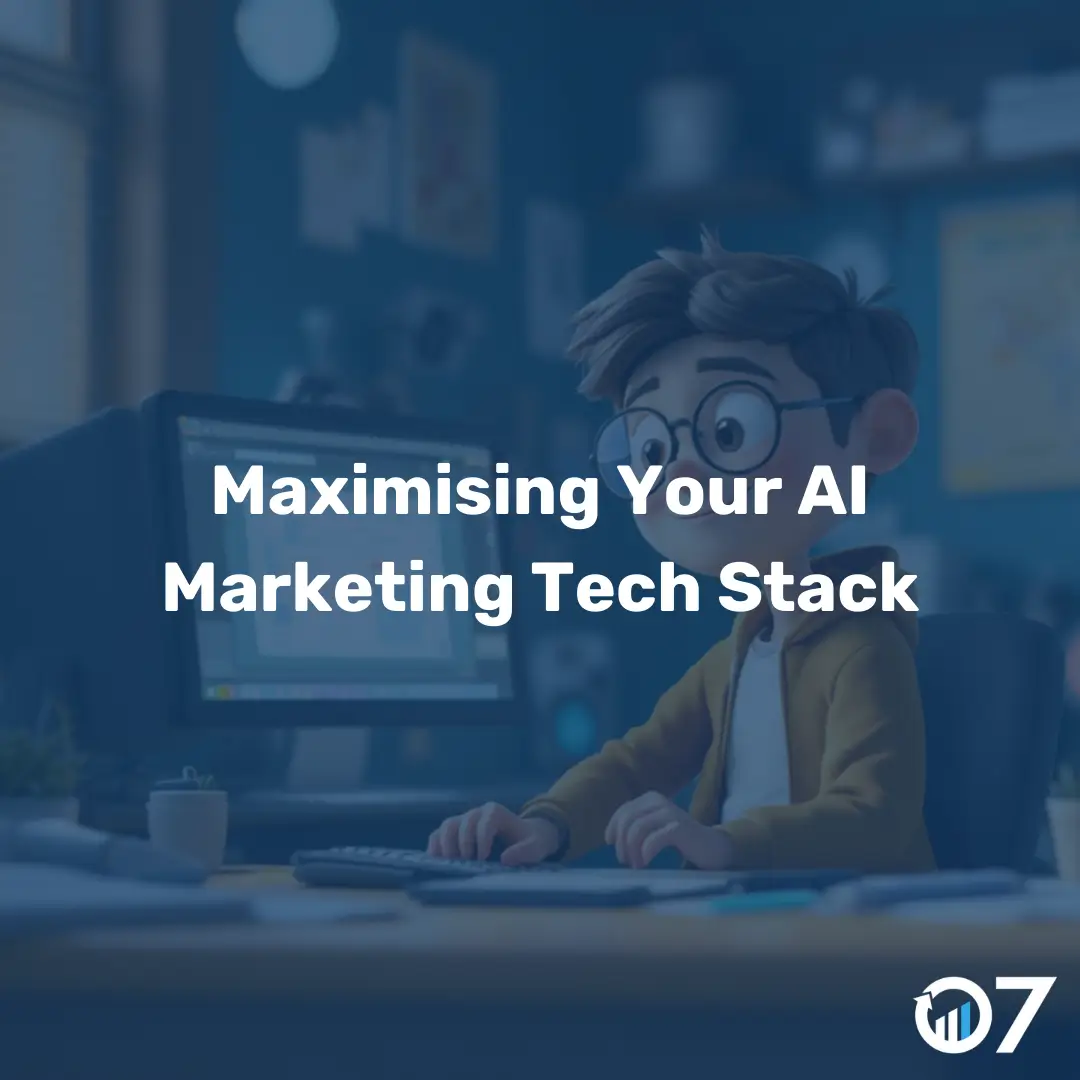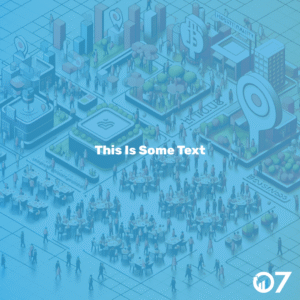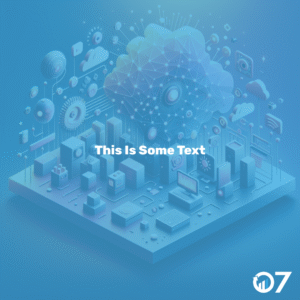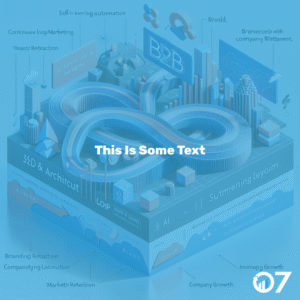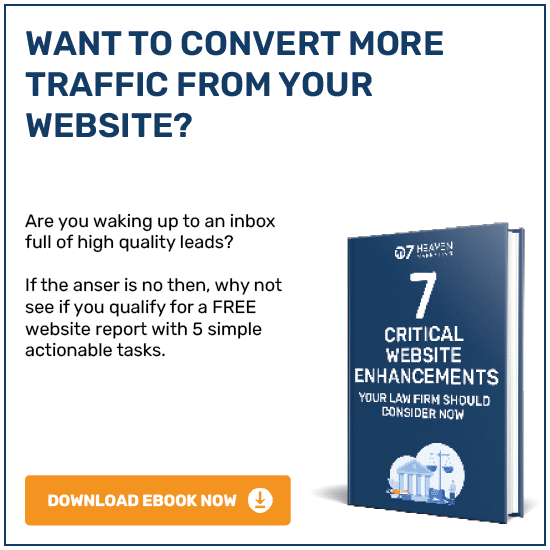Maximising your AI marketing tech stack can revolutionise your business operations and marketing funnels. Read on to discover how you can harness AI to personalise marketing, deepen customer relationships, and boost efficiency.
Long before ChatGPT made headlines, I was working with clients who utilised AI and machine learning to accelerate data analysis on a large scale. Their excitement about AI’s potential to enhance everything from business operations to marketing funnels sparked my interest.
When ChatGPT entered the scene, I was initially skeptical, but I quickly realised the transformative power of a robust AI marketing tech stack. While it’s crucial to approach AI with a critical eye, it offers businesses of all sizes opportunities to personalise marketing, improve customer intimacy, and enhance the efficiency and effectiveness of marketing programs.
More importantly, AI lowers the barrier to entry for sophisticated marketing efforts, enabling better interaction and relationship-building with customers. Let’s dive into how you can incorporate AI into your marketing funnel.
AI and the Marketing Funnel
Before discussing how AI can enhance your marketing funnel, it’s essential to understand what a marketing funnel is and how it works. The purpose of a marketing funnel—or flywheel—is to map out each stage of the buyer journey and improve the way customers move through it.
Without a solid understanding of the marketing funnel, you can’t effectively automate or optimise it. Knowing the expected outcomes is crucial to evaluate AI recommendations, identify what’s working, and find effective solutions.
Now, let’s explore how AI can improve various aspects of the marketing funnel, including the buyer journey and beyond.
Understanding The Buyer Journey
Here’s a quick recap of the typical buyer journey, the associated marketing tasks, and the opportunities for AI marketing funnel optimisation.
Awareness Stage
During this phase, prospective buyers are aware of a problem but may not yet know the solution. They search for information to understand their pain points.
Marketing Tasks & Challenges
Marketers working through awareness stage tactics spend time:
- Identifying target audiences and key messages.
- Understanding buyer pain points.
- Creating and optimising content that addresses problems and solutions.
Common challenges include:
- Analysing whether the right audience is being reached.
- Ensuring content speaks to different segments and pain points.
- Generating leads.
AI Marketing Tech Stack Funnel Opportunities
AI can significantly enhance prospecting and lead scoring. For example, the “Likely to Engage” score in ZoomInfo helps identify the best targets for initial contact. Other ways AI can assist in the awareness stage include:
- Segmenting audiences based on shared interests, demographics, or problems.
- Personalising content by pushing it to the right audience at the right time and tailoring it based on data analysis.
- Targeting ads based on the likelihood of engagement and lookalike audiences.
- Using predictive analytics to determine which content, channels, and formats are most likely to pay off.
Pro tip: Use AI to identify where customers are and deliver the right message at the right time. Adam Tishman, co-founder of Helix Sleep, says, “AI allows us to know which customers are in which marketing funnel stage by using historical data to categorise them based on their behaviour.” This has led to a 32% increase in engagement.
Consideration Stage
At this stage, buyers are solution-aware. They know solutions to their problem exist and are actively evaluating their options but may not be familiar with your specific product or service yet.
Marketing Tasks & Challenges
Marketers focused on the consideration stage typically:
- Develop and distribute content that helps buyers evaluate options, such as product comparisons, case studies, and expert guides.
- Track engagement across channels to gauge interest levels.
- Nurture leads with personalised email campaigns or retargeting ads.
Common obstacles include:
- Determining which leads are genuinely interested versus those who are just browsing.
- Providing the right information at the right time without overwhelming leads.
- Balancing personalisation with scale, especially with a large volume of leads.
AI Marketing Tech Stack Funnel Opportunities
AI offers several advantages for optimising the consideration stage, such as:
- Lead scoring to prioritise high-potential prospects.
- Content recommendations to identify engaging content and suggest the next best content to keep leads moving through the funnel.
- Automated email nurturing to segment leads and deliver content based on specific triggers without constant manual input.
- Behavior analysis to assess buyer intent and adjust messaging based on real-time interest levels.
Pro tip: Don’t rely completely on AI—the personal touch still matters. Roland Jakob of Blazekin.Media shares, “AI spots patterns and predicts actions, but it’s on us to craft messaging that resonates personally. In my early experiences with AI, I relied on it too much for customer interactions. It’s tempting to automate everything, but I quickly realised that complicated conversations and decisions need a human touch.”
Decision Stage
By the decision stage, buyers understand their problem, know the potential solutions, and are evaluating providers. They’re comparing products, seeking validation through demos or testimonials, and are ready to make a final decision.
Marketing Tasks & Challenges
Marketers supporting the decision stage typically:
- Offer product demos, trials, or consultations to build confidence.
- Personalize discounts or promotions to help close deals.
- Address buyer objections and provide quick answers to final questions.
Common sales-related challenges include:
- Closing high-intent leads effectively without seeming overly aggressive.
- Personalising the buying experience while ensuring consistency.
- Following up at appropriate intervals.
AI Marketing Tech Stack Funnel Opportunities
AI can streamline the decision-making process by:
- Predicting conversions to identify leads most likely to convert, allowing for more effective prioritisation of high-potential customers.
- Personalising offers based on previous behaviors to increase the likelihood of conversion.
- Automating follow-ups to ensure high-intent leads receive the right message at the right time.
- Providing chatbot support to handle common buyer questions and objections in real-time, supporting purchase decisions.
Pro tip: Use AI to fine-tune timing and personalisation to improve conversions. John Pennypacker, vice president of sales and marketing at Deep Cognition, explains how AI has transformed his team’s approach to conversions. “We use AI-powered lead scoring to prioritise high-potential leads and AI content optimisation tools to fine-tune messaging,” he says. By combining predictive insights with tailored offers, his team increased content engagement by 35% in just two months.
Onboarding, Engagement, and Retention
While not technically part of the buyer journey, onboarding your customers and keeping them engaged is an essential part of marketing operations. People are more likely to stick around if they use and like your product.
Acquiring new customers is significantly more expensive than retaining existing ones, making customer experience one of the most important areas to invest marketing dollars. B2B marketers devote more energy to deepening relationships with existing companies than nurturing new leads and serious opportunities.
Marketing Tasks & Challenges
Marketers working with CX teams to improve retention and customer satisfaction typically:
- Follow up with customers to ensure satisfaction and offer support.
- Create opportunities for upsells, cross-sells, and loyalty rewards.
- Gather feedback through surveys or reviews to improve the customer experience.
Common challenges include:
- Maintaining engagement momentum.
- Identifying the right moments to suggest upsells or cross-sells.
- Recognising and addressing signs of disengagement early.
AI Marketing Tech Stack Funnel Opportunities
AI has tremendous potential in post-purchase nurturing and retention. It can help by:
- Automating personalised follow-ups based on purchase history, engagement, and likely behaviors.
- Monitoring behavior to detect opportunities for upselling or cross-selling based on previous purchases and browsing patterns.
- Predicting churn to identify customers showing signs of disengagement or dissatisfaction and trigger actions to keep them engaged.
- Providing personalised product and resource recommendations to improve customer experience and increase lifetime value.
Pro tip: Use AI to help customers feel valued and understood. Consultant Nora Sudduth points out, “AI shines when used to segment audiences and deliver personalised experiences that allow the relationship to deepen.”
How to Build a Marketing Funnel With AI
With these insights and a deeper understanding of the challenges marketers face at each stage of the marketing funnel, it’s important to note that there’s no one right way to build or optimise your marketing funnel with AI.
Most businesses already have some marketing funnel components in place. Restarting from scratch is rarely recommended unless your systems are fundamentally broken. Instead, consider enhancing your existing setup with AI.
Step 1: Map and Analyse Your Current Funnel
The best place to start is by understanding what you have now, what’s working, and where you have the biggest opportunities. By mapping out your funnel and every touchpoint, you can identify strengths, weaknesses, and opportunities to optimise. AI speeds this up, giving you something to react to so you can adapt and adjust as you go.
Tools like Breeze, Google Analytics, and Google Search Console can help identify which pages perform well and where you have opportunities to optimise. Depending on your email marketing program, you can also get detailed reporting on open and conversion rates.
Pro tip: Map your customer journey with AI. Arthur Favier, founder and CEO of Oppizi, shares, “AI steps in to spot where people are dropping off and why. Maybe your potential customers love the content you’re putting out, but they’re getting lost right before making a decision.”
Step 2: Identify, Define, and Segment Your Audience
AI can confirm your gut feeling about your audience. Once you define who your top clients or customers are, you can use AI tools like Breeze and Copy.ai to get insights into your target market segments, trends, purchase behavior, and content preferences.
Generative AI tools like ChatGPT or Claude can analyse customer conversations and reviews to get deeper insights into how they talk about their problems.
Pro tip: Use AI to get precise audience segmentation and targeting. Dominick Tomanelli, co-founder and CEO of Promobile Marketing, says, “AI can break it down into the smallest details, like ‘males 25-35 who’ve shown interest in sustainable products and have visited our site more than three times in the last month.’ This kind of precision lets us serve content that’s hyper-relevant, and that’s how we keep people engaged.”
Step 3: Identify and Tailor Your Message
Once you know your audience and how they think about their problems, you can start tailoring your messaging to speak directly to their needs. Tools like Breeze and Copy.ai can help ensure that you’re tailoring your message to their needs, while AI content tools like Jasper and ChatGPT can suggest message themes, helping to craft content that resonates with different audience segments.
Step 4: Catalog Your Content and Identify Opportunities for Repurposing
The best way to personalise content isn’t creating an entire library of new information—it starts with making the most out of the content you’re already creating. AI-driven content analysis can reveal that a popular blog post might perform well as a lead magnet, or that a webinar could be repurposed as short-form videos or infographics for social media. Or, it might find that it performs well as a series of emails dripped out.
Step 5: Automate Lead Nurturing
AI-driven lead nurturing takes carefully designed paths and puts them on steroids, delivering content based on each lead’s activity and engagement level. AI-enabled tools like HubSpot’s Marketing Hub, Adobe Marketo, or ActiveCampaign can trigger follow-ups and content offers automatically. AI tools can monitor engagement signals and send relevant follow-ups when leads are most likely to take action, increasing conversion chances.
Pro tip: Timing is everything. Rafikuzzaman Khan, co-founder and COO of Microters, says, “I’ve been personally using AI to create funnels, and AI tools allow me to analyse data in real-time and develop customer personas almost instantly. We’ve seen conversion rates increase by up to 40% when we use AI to design funnels that speak directly to the customer’s needs.”
Step 6: Analyse and Optimise
The market is always changing, customer expectations are evolving, and technology is continually maturing. You can’t set and forget any of your marketing efforts and expect consistent performance. Continually analyse performance using any of the tools mentioned here and use the resulting insights to find opportunities to fine-tune targeting, messaging, and content based on performance metrics.
Pro tip: Use GA4 purchase probability to identify customers likely to buy. Victor Karpenko, founder and CEO of SEOProfy, says, “GA4 has some amazing AI features for predictive analysis. You can set up a few filters to get insights that’ll boost your repeat purchases and optimize your marketing spend. Try creating segments based on purchase probability and predicted revenue.”
Tips for Making the Most of AI in Your Marketing Funnel and MarTech Operations
AI is an incredible tool to have in your arsenal—it can make you a more effective marketer. Here’s some top advice on how to use AI in your marketing funnel based on expert advice.
Identify Which Tools You Already Have
If you’re using a MarTech tool, there’s a good chance it now has some AI capabilities. Before adding new tools, evaluate the AI capabilities you already have access to. When you do need new tools, look for those with native integrations with your existing platforms or that can easily integrate through Zapier or open API.
Pro tip: Choose the right tools for the job. Khan says, “The biggest mistake most brands make is implementing too many AI tools at once, which leads to disorganisation and inefficiency.”
Personalise at Every Stage of the Funnel
AI-powered personalisation increases engagement and builds stronger customer relationships. Tailor content based on real-time engagement to keep leads moving through the funnel.
Pro tip: Tailor content based on real-time engagement. Villam Karasti of Pardott says doing so has led to a 25% increase in response rates. “I use Breeze Copilot to analyse engagement data and trigger personalised workflows. When leads reach specific engagement thresholds, they’re automatically entered into tailored sequences. The platform’s lead scoring and buyer intent features help me focus on high-potential leads while automating repetitive tasks like follow-ups and email sequences,” Karasti says.
Get Really Good at Writing Prompts
As generative AI grows increasingly sophisticated, understanding how to best interact with platforms like ChatGPT is crucial. One of the best courses I’ve taken was AI for Copywriters by The Copywriter Club—I learned so much about how generative AI works and some of its capabilities.
Pro tip: Use bite-sized prompts. Lori Highby of Keystone Click notes that asking for an entire marketing plan produces results, but they’re not well-thought-out. “For example, rather than asking AI to create an entire marketing funnel, start by asking AI to gather data on your target audience, their pain points, and their typical customer journey. This will help you determine the next steps related to creating content that resonates with that audience while nurturing and guiding them through their preferred customer journey,” Highby says.
Automate Repetitive Tasks
One of AI’s best features is its ability to automate repetitive tasks. If there’s something you do that takes a ton of time, there’s likely a way AI can streamline that part of your MarTech operations.
Pro tip: The best part of AI doesn’t have to be the complicated stuff—it can be about simplifying the simple stuff. Nora Sudduth shares, “One of the best use cases for AI is doing the heavy lifting on simple, repetitive, otherwise time-consuming tasks. AI-driven automation workflows can send specific follow-up emails after a certain trigger, schedule out social media posts, push an email cadence to nurture a segment of your email list, and so much more.”
Know Where AI Stops and Your Brain Starts
AI is only a tool. You and I have two things it never will—humanity and creativity. These qualities are essential for managing your marketing funnel.
Pro tip: Treat AI as an assistant, not a replacement. Abraham Ernesto, co-founder of GiantFocal, shares, “No one can deny that AI is an incredible assistant in the marketing space. However, I don‘t think AI can replace the ‘creative mind’ that plans the entire marketing funnel, or at least no AI in the market today can. The strategic decisions that drive the funnel’s overall plan still rely on human creativity and intuition.”
AI is the Future of Marketing Funnels
There’s no one best way to use AI in marketing funnels, but there are a few areas to avoid. Strangely enough, they lie in the extremes: not using AI at all and using AI for everything.
The best practices lie in the middle, where we balance AI with human insight. Small adjustments are the best place to start—they allow you to get a sense of AI’s capabilities without overwhelming your processes or team.
AI Marketing Tech Stack Conclusion
Anyone not willing to test and iterate with AI will be left behind. Here’s to the future of marketing, where AI is more than just a tool—it’s the key to creating more dynamic, responsive, and impactful marketing funnels.
For more insights and tips, visit our blog or contact us via email at info@07hm.co.uk or telephone at 01702 410663.

